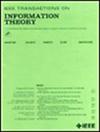一种新的最优排列同步谱方法
IF 2.2
3区 计算机科学
Q3 COMPUTER SCIENCE, INFORMATION SYSTEMS
引用次数: 0
摘要
排列同步是计算机科学中的一个重要问题,是许多计算机视觉任务的关键步骤。目标是从它们的噪声和不完全成对测量中恢复n个潜在排列。近年来,光谱方法以其简单、高效的优点得到了越来越多的应用。谱方法利用数据矩阵的前导特征空间U及其块子矩阵$U_{1},U_{2},\ldots , U_{n}$来恢复排列。在本文中,我们提出了一种新的统计上最优的谱算法。与使用$\{U_{j}U_{1}^{\top } \}_{j\geq 2}$的现有方法不同,我们的方法通过聚合来自所有块子矩阵的有用信息来构建锚矩阵M,并通过$\{U_{j}M^{\top } \}_{j\geq 1}$估计潜在排列。这种改进克服了由于重复使用$U_{1}$而导致的现有方法的一个关键限制,并导致了数值性能的提高。为了确定该方法的最优性,我们进行了细粒度的谱分析,并获得了与极大极小率匹配的尖锐指数误差界。本文章由计算机程序翻译,如有差异,请以英文原文为准。
A Novel and Optimal Spectral Method for Permutation Synchronization
Permutation synchronization is an important problem in computer science that constitutes the key step of many computer vision tasks. The goal is to recover n latent permutations from their noisy and incomplete pairwise measurements. In recent years, spectral methods have gained increasing popularity thanks to their simplicity and computational efficiency. Spectral methods utilize the leading eigenspace U of the data matrix and its block submatrices $U_{1},U_{2},\ldots , U_{n}$ to recover the permutations. In this paper, we propose a novel and statistically optimal spectral algorithm. Unlike the existing methods which use $\{U_{j}U_{1}^{\top } \}_{j\geq 2}$ , ours constructs an anchor matrix M by aggregating useful information from all of the block submatrices and estimates the latent permutations through $\{U_{j}M^{\top } \}_{j\geq 1}$ . This modification overcomes a crucial limitation of the existing methods caused by the repetitive use of $U_{1}$ and leads to an improved numerical performance. To establish the optimality of the proposed method, we carry out a fine-grained spectral analysis and obtain a sharp exponential error bound that matches the minimax rate.
求助全文
通过发布文献求助,成功后即可免费获取论文全文。
去求助
来源期刊

IEEE Transactions on Information Theory
工程技术-工程:电子与电气
CiteScore
5.70
自引率
20.00%
发文量
514
审稿时长
12 months
期刊介绍:
The IEEE Transactions on Information Theory is a journal that publishes theoretical and experimental papers concerned with the transmission, processing, and utilization of information. The boundaries of acceptable subject matter are intentionally not sharply delimited. Rather, it is hoped that as the focus of research activity changes, a flexible policy will permit this Transactions to follow suit. Current appropriate topics are best reflected by recent Tables of Contents; they are summarized in the titles of editorial areas that appear on the inside front cover.
 求助内容:
求助内容: 应助结果提醒方式:
应助结果提醒方式:


